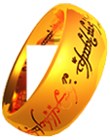Things of Middle-earth
Wilwarin
Type: Miscellaneous
Meaning: butterfly
Other Names:
Vilvarin (HoME only)
Description:
The Quenya name of a constellation, probably the real-life circumpolar cluster of five bright stars shaped like the letter "W" in the constellation Cassiopeia; in the middle latitudes of the Northern Hemisphere, where Middle-earth supposedly lies, the constellation is visible above the horizon throughout the year, circling the sky on the opposite side of Polaris, the North Star, as the Plough (Big Dipper).
[Varda] took the silver dews from the vats of Telperion, and therewith she made new stars and brighter against the coming of the Firstborn; wherefore she whose name out of the deeps of time and the labours of Eä was Tintallë, the Kindler, was called after by the Elves Elentári, Queen of the Stars. Carnil and Luinil, Nénar and Lumbar, Alcarinquë and Elemmírë she wrought in that time, and many other of the ancient stars she gathered together and set as signs in the heavens of Arda: Wilwarin, Telumendil, Soronúmë, and Anarríma....
The Silmarillion, Quenta Silmarillion, Ch 3, Of The Coming of the Elves and the Captivity of Melkor
Wilwarin Name of a constellation. The word meant 'butterfly' in Quenya, and the constellation was perhaps Cassiopeia.
The Silmarillion, Index of Names
Etymology
WIL- fly, float in air. *wilwā air, lower air, distinct from the ‘upper’ of the stars, or the ‘outer’ (see way); Q wilwa > vilwa; N gwelw air (as substance); gwelwen = Q vilwa; Ilk. gwelu, gwelo. Q vilin I fly, pa.t. ville. N gwilith ‘air’ as a region = Q vilwa; cf. gilith = Q ilmen (see gil). Q wilwarin (pl. wilwarindi) butterfly; T vilverin; N gwilwileth; Ilk. gwilwering.[The name Wilwa of the lower air is found also in the preparatory outline for The Fall of Númenor (p. 12), whereas Wilwa in the Ambarkanta was changed throughout to Vista, and so also on the accompanying world-diagrams (IV. 240-7). By subsequent pencilled changes the forms *wilwā, Q wilwa were changed to *wilmā, Q wilma; Q wilwa > vilwa was struck out; and Q vilin was changed to wilin. A new stem wis with derivative Q vista (see below) was introduced, either at the same time or later, but the stem wil was allowed to stand.]
The Lost Road and Other Writings, HoME Vol 5, Part 3, The Etymologies
Notes
For further information about the real-life constellation, see the Cassiopeia entry in Wikipedia. To see how it actually appears in the night sky, see Catching the Light: Astrophotography by Jerry Lodriguss.
Contributors:
Elena Tiriel 11Oct07, 7Mar10

